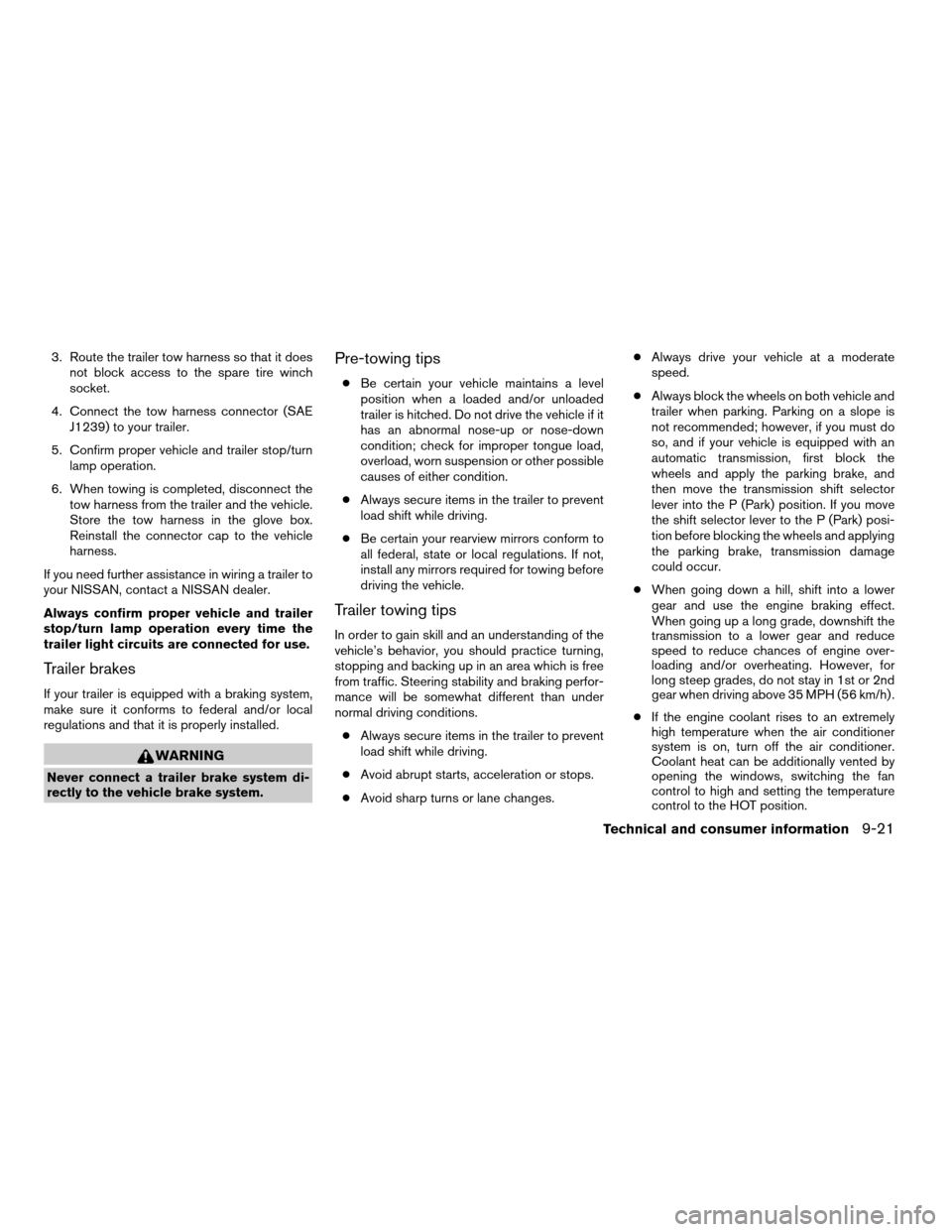2004 NISSAN XTERRA ECO mode
[x] Cancel search: ECO modePage 272 of 296

TOWING LOAD/SPECIFICATION
CHART
Unit: lbs (kg)
Engine KA24DE (4 cyl) VG33E/VG33ER (V6)
Model 2WD 2WD 4WD
Transmission M/T M/T A/T M/T A/T
Maxiumum Trailer Weight*1 3,500 (1,588) 3,500 (1,588) 5,000 (2,268) 3,500 (1,588) 5,000 (2,268)
Maximum Tongue Load 350 (159) 350 (159) 500 (227) 350 (159) 500 (227)
Gross Combined Weight
Rating7,700 (3,492) 8,000 (3,628) 9,500 (4,309) 8,000 (3,628) 9,500 (4,309)
Recommended
Equipment*2Sway Control Device Sway Control Device Sway Control Device Sway Control Device Sway Control Device
*1: All towing above 1,000 lb (454 kg) requires the use of trailer brakes. NISSAN recommends the use of a tandem axle trailer whenever towing above 3,000lb (1,361 kg) .
*2: A sway control device is recommended for all towing above 2,000 lb (907 kg) . Sway control devices are not offered by NISSAN. See a professional trailer/hitch outlet for a prop-
erly designed sway control device for your trailer.
M/T = Manual Transmission
A/T = Automatic Transmission
2WD = 2-wheel drive
4WD = 4-wheel drive
9-18Technical and consumer information
ZREVIEW COPY:Ð2004 Xterra(xtr)
Owners Manual(owners)ÐUSA English(nna)
10/23/03Ðdebbie
X
Page 275 of 296

3. Route the trailer tow harness so that it does
not block access to the spare tire winch
socket.
4. Connect the tow harness connector (SAE
J1239) to your trailer.
5. Confirm proper vehicle and trailer stop/turn
lamp operation.
6. When towing is completed, disconnect the
tow harness from the trailer and the vehicle.
Store the tow harness in the glove box.
Reinstall the connector cap to the vehicle
harness.
If you need further assistance in wiring a trailer to
your NISSAN, contact a NISSAN dealer.
Always confirm proper vehicle and trailer
stop/turn lamp operation every time the
trailer light circuits are connected for use.
Trailer brakes
If your trailer is equipped with a braking system,
make sure it conforms to federal and/or local
regulations and that it is properly installed.
WARNING
Never connect a trailer brake system di-
rectly to the vehicle brake system.
Pre-towing tips
cBe certain your vehicle maintains a level
position when a loaded and/or unloaded
trailer is hitched. Do not drive the vehicle if it
has an abnormal nose-up or nose-down
condition; check for improper tongue load,
overload, worn suspension or other possible
causes of either condition.
cAlways secure items in the trailer to prevent
load shift while driving.
cBe certain your rearview mirrors conform to
all federal, state or local regulations. If not,
install any mirrors required for towing before
driving the vehicle.
Trailer towing tips
In order to gain skill and an understanding of the
vehicle’s behavior, you should practice turning,
stopping and backing up in an area which is free
from traffic. Steering stability and braking perfor-
mance will be somewhat different than under
normal driving conditions.
cAlways secure items in the trailer to prevent
load shift while driving.
cAvoid abrupt starts, acceleration or stops.
cAvoid sharp turns or lane changes.cAlways drive your vehicle at a moderate
speed.
cAlways block the wheels on both vehicle and
trailer when parking. Parking on a slope is
not recommended; however, if you must do
so, and if your vehicle is equipped with an
automatic transmission, first block the
wheels and apply the parking brake, and
then move the transmission shift selector
lever into the P (Park) position. If you move
the shift selector lever to the P (Park) posi-
tion before blocking the wheels and applying
the parking brake, transmission damage
could occur.
cWhen going down a hill, shift into a lower
gear and use the engine braking effect.
When going up a long grade, downshift the
transmission to a lower gear and reduce
speed to reduce chances of engine over-
loading and/or overheating. However, for
long steep grades, do not stay in 1st or 2nd
gear when driving above 35 MPH (56 km/h) .
cIf the engine coolant rises to an extremely
high temperature when the air conditioner
system is on, turn off the air conditioner.
Coolant heat can be additionally vented by
opening the windows, switching the fan
control to high and setting the temperature
control to the HOT position.
Technical and consumer information9-21
ZREVIEW COPY:Ð2004 Xterra(xtr)
Owners Manual(owners)ÐUSA English(nna)
10/23/03Ðdebbie
X
Page 279 of 296

2. Accelerate the vehicle to 55 mph (88 km/h) ,
then quickly release the accelerator pedal
completely and keep it released for at least 6
seconds.
3. Quickly depress the accelerator pedal for a
moment, then drive the vehicle at a speed of
53 - 60 mph (85 - 97 km/h) for at least 5
minutes.
4. Stop the vehicle.
5. Accelerate the vehicle to 35 mph (55 km/h)
and maintain the speed for 20 seconds.
6. Repeat steps 4 through 5 at least three
times.
7. Accelerate the vehicle to 55 mph (88 km/h)
and maintain the speed for at least 3 min-
utes.
8. Stop the vehicle and turn the engine off.
9. Repeat steps 1 through 8 at least one more
time.
If steps 1 through 7 are interrupted, repeat the
preceding step. Any safe driving mode is accept-
able between steps. Do not stop the engine until
step 7 is completed. If you cannot or do not want
to perform the driving pattern, a NISSAN dealer
can conduct it for you.DYNAMOMETER TESTING FOR
INSPECTION/MAINTENANCE (I/M)
TEST (US only)
Due to legal requirements in some states/areas,
your vehicle may be tested for emissions on a
dynamometer. The transfer control lever (if so
equipped) MUST be in the 2H position for I/M
testing on a two wheel dynamometer.
WARNING
cIf the transfer control lever is not in the
2H position during the dynamometer
I/M testing, the vehicle could come off
the dynamometer and cause serious
personal injury and/or body damage to
the vehicle.
cSerious damage will occur to the 4WD
system if the transfer control lever is
not in the 2H position.
Technical and consumer information9-25
ZREVIEW COPY:Ð2004 Xterra(xtr)
Owners Manual(owners)ÐUSA English(nna)
10/23/03Ðdebbie
X
Page 287 of 296

Shifting
Automatic transmission...........5-11
Manual transmission............5-14
Shoulder belt height adjustment........1-27
Spark plug replacement............8-21
Speedometer...................2-3
Spotlights (See map light)...........2-41
SRS warning label...............1-19
Starting
Before starting the engine..........5-9
Jump starting.................6-9
Precautions when starting and driving . . .5-2
Push starting................6-11
Starting the engine..............5-9
Steering
Power steering fluid.............8-15
Power steering system...........5-23
Tilting steering wheel............3-13
Steering wheel audio control switch......4-28
Step rail.....................3-11
Stop light....................8-36
Storage.....................2-26
Sunroof.....................2-39
Supplemental air bag warning light . . .1-19, 2-13
Supplemental restraint system
Information and warning labels.......1-19
Precautions on supplemental restraint
system.....................1-8
Supplemental restraint system
(Supplemental air bag system).........1-8
Switch
Automatic power window switch.....2-38
Fog light switch...............2-22
Hazard warning flasher switch.......2-23
Headlight and turn signal switch......2-20
Ignition switch................5-7Overdrive switch..............5-13
Power door lock switch...........3-3
Rear window defogger switch.......2-20
Rear window wiper and washer
switches...................2-19
Vehicle dynamic control (VDC) off
switch....................2-24
Windshield wiper and washer switch . . .2-18
T
Tachometer....................2-5
Temperature gauge
Engine coolant temperature gauge.....2-5
Engine oil pressure low/engine coolant
temperature high warning light.......2-11
Three-way catalyst................5-2
Tie down hooks.................2-31
Tilting steering wheel..............3-13
Tire
Flat tire....................6-2
Spare tire...................6-4
Tire chains..................8-46
Tire placard.................9-11
Tire pressure................8-40
Tire rotation.................8-47
Tires of 4-wheel drive............8-49
Types of tires................8-46
Uniform tire quality grading.........9-23
Wheels and tires..............8-40
Wheel/tire size................9-8
Tire pressure
Low tire pressure warning light......2-11
Top tether strap child restraint.........1-41Towing
2-wheel drive models............6-13
4-wheel drive models............6-14
Flat towing..................9-22
Tow truck towing..............6-12
Towing load/specification chart......9-18
Trailer towing................9-16
Transfer case..................5-19
Transmission
Automatic transmission fluid (ATF). . . .8-14
Driving with automatic transmission. . . .5-10
Driving with manual transmission.....5-14
Selector lever lock release.........5-13
Travel (See registering your vehicle in another
country)......................9-9
Turn signal switch (See headlight and turn
signal switch)...............2-20, 2-22
U
Uniform tire quality grading...........9-23
V
Vanity mirror...................3-13
Vehicle dimensions and weights........9-8
Vehicle dynamic control (VDC) off switch. . .2-24
Vehicle dynamic control (VDC) system. . . .5-25
Vehicle identification...............9-9
Vehicle identification number (VIN)
(Chassis number).................9-9
Vehicle identification number (VIN) plate. . . .9-9
Vehicle loading information...........9-12
Vehicle recovery.................6-15
10-5
ZREVIEW COPY:Ð2004 Xterra(xtr)
Owners Manual(owners)ÐUSA English(nna)
10/23/03Ðdebbie
X